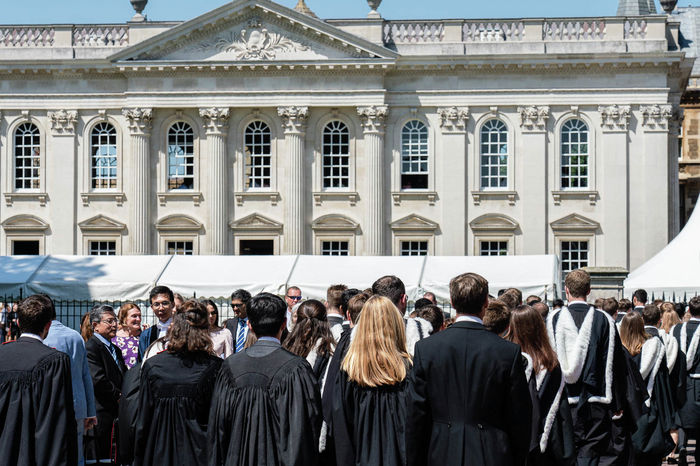University of Cambridge placed 22nd in ranking of social mobility
The Higher Education Policy Institute (HEPI) has ranked Cambridge 22nd in a list of English universities scored on a new Social Mobility Index

The University of Cambridge was placed 22nd in a recent ranking of forty English universities for its contribution to the social mobility of its graduates. The ranking, compiled by the Higher Education Policy Institute (HEPI), was assessed through the use of the English Social Mobility Index (SMI).
This position is worse than the University’s rank calculated with data from 2017/18, which placed Cambridge 15th.
The universities in the top ten include a range of Russell Group and MillionPlus universities, such as the University of Bradford, which ranked at number one, as well as King’s College London.
Cambridge’s position in the rankings reflects a comparatively low percentage of students coming from lower socio-economic backgrounds. The report showed that only 16.8% of students came from the most deprived postcodes, as identified in the Index of Multiple Deprivation (IMD). In comparison, Queen Mary University of London was found to have 49.3% of students obtaining places from the IMD1 and IMD2 postcodes.
A University spokesperon, responding to the rankings, told Varsity: “The University is pleased that we are increasingly attracting more applications from under-represented groups. Last year, using a combination of the lowest POLAR and IMD measures, we welcomed more than a quarter of our UK freshers from these backgrounds, a significant improvement on 5 years ago.
As well as assessing access statistics, the SMI considered average earnings after graduation, for which Cambridge placed 2nd in the table at £28,222, behind Imperial whose graduates were earning, on average, £33,117.
The English SMI is a new ranking system which assesses how universities contribute to the social mobility of their graduates. It only takes into consideration English universities, and English students at those universities, in order to use comparable data.
The declared aim of the English SMI is to address the issue that “the most advantaged students are 2.26 times more likely to enter higher education. For universities with the high entry tariffs, such as Cambridge, Oxford, and Bath, this increases to 4.7 times.”
Furthermore, it aims to break what it calls the “vicious circle” which emerges when ranking systems rely upon UCAS tariffs when making measurements.
Certain institutions which benefit from the prestige associated with more demanding UCAS tariffs see an increase in applications, and are therefore incentivised to increase tariffs even further. On average, learners from higher socio-economic backgrounds will achieve high UCAS tariff scores, so league tables actively rewarding these universities is “inherently detrimental to social mobility”.
The report also criticises social mobility rankings which focus heavily on access statistics, such as how many students from a certain socio-economic or identity background are admitted. Such rankings “tell us little or nothing about universities’ contributions to social mobility in terms of the added value they provide to their graduates”, the report says.
By contrast, “it is not possible for an institution to perform highly in [the English SMI] while providing high levels of access but poor outcomes.” The English SMI ranking combines rankings based on three areas: “access”, “continuation”, and “graduate salaries” to produce an overall score.
The “access” and “continuation” elements draw on data showing the demographic makeup of students entering higher education, as well as the numbers that progress from first to second year, and their final attainment.
The report uses data from the IMD to assess “the impact of higher education on deprivation” by showing the proportion of disadvantaged learners who “progress successfully” through the higher education system.
The final metric identifies how much graduates are earning after graduation, adjusted for Purchasing Power Parity (PPP).
The report notes the differences between universities in the UK compared with the United States in terms of their contribution to social mobility. While in the US, top universities such as Harvard, all sit outside the top 1000 when using a similar social mobility ranking, in the English SMI Russell Group universities are represented at all levels of the ranking. The report suggests that this is partially due to the ability of American universities to set their own fees, thus the pool of applicants is, in some cases, limited by financial accessibility.
In the Cambridge Access and Participation Plan 2020-2025, the University acknowledges that there is still work to be done, stating: “Our ultimate objectives are to admit a student body in which no identified priority group is under-represented, and to eliminate gaps between such groups in continuation, attainment and progression.”
The statement continues: “There are many social, economic and educational factors which mean that the population from which the higher education sector draws is already unequal and which have limited and will continue to limit this ambition.”
It further states that the University’s goal is to have a third of its intake drawn from “the most under-represented and disadvantaged groups,” which they define as the bottom quintiles of POLAR (Participation of Local Areas) and IMD measures of deprivation.
A University spokesperson further detailed to Varsity: “We’re proud of our high retention rate, which, at 99%, is the highest in the country, and that this applies equally to the most under-represented groups; our graduates from those groups also go on to earn more than the average. It is these factors which mean that Cambridge is the top-ranked Russell Group institution in the index outside of London.”
 News / SU reluctantly registers controversial women’s soc18 December 2025
News / SU reluctantly registers controversial women’s soc18 December 2025 Features / Should I stay or should I go? Cambridge students and alumni reflect on how their memories stay with them15 December 2025
Features / Should I stay or should I go? Cambridge students and alumni reflect on how their memories stay with them15 December 2025 News / Dons warn PM about Vet School closure16 December 2025
News / Dons warn PM about Vet School closure16 December 2025 News / Cambridge study finds students learn better with notes than AI13 December 2025
News / Cambridge study finds students learn better with notes than AI13 December 2025 News / CUP announces funding scheme for under-represented academics19 December 2025
News / CUP announces funding scheme for under-represented academics19 December 2025









